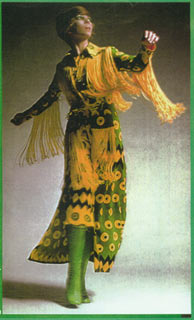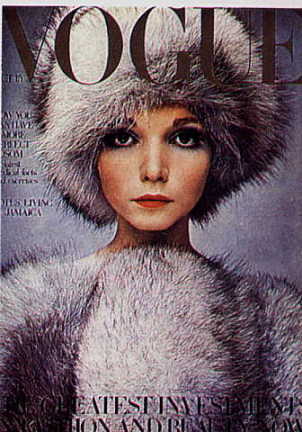|

She came from a rich and traditional English family who didn't
appreciate her rebellious decision as a young teen to become a model. Her father was a multimillionaire, and her mother Marietta
was the first woman delegate to the United Nations, and she had many powerful and famous friends in politics. The legendary
photographer Diane Arbus discovered Penelope when she was only thirteen, and her outraged parents promised a lawsuit if pictures
of her were published. She didn't make it into a magazine (Mademoiselle) until '65, when she was fifteen. At seventeen
she met with Vogue editor Diana Vreeland. Penelope herself said that she first encountered both Vreeland and photographer
Richard Avedon at the Black and White Ball thrown in late '66 by Truman Capote. Supposedly some of the Vogue editors thought she was too
gawky and plain, but Avedon saw the strange beauty within her. According to Michael Gross's Model: The Ugly Business of
Beautiful Women, Avedon knew Penelope was a rare find: "She's perfect," he declared, "don't touch her." Avedon then shot
her for Vogue, and her rep spread around the world. By this time her family relented in their opposition. Penelope
was on three Vogue covers during the decade.
Richard Avedon once said of her, "Penelope is never only of today.
To each gesture she brings a sense of all the things that have ever interested her, out of this she invents every moment a
new little role for herself which she plays with devastating humor ... she is a delight." Her best talent may have been for
being original, according to famed photographer David Bailey: "Penelope Tree is the most original model there's ever been.
She's the most original-looking girl I've ever seen." Still, there's no evidence of any acting, musical, or otherwise creative
talent, unlike Jean Shrimpton and Twiggy, both of whom at least attempted movie careers and wrote
books.
HER '60s LOOK: "The face of the decade" she was called by Women's Wear Daily.
Photographers loved her, so she must've been doing something right. She had a face like a doll, at once young and innocent
but with a scary force behind the eyes, amplified by her sometimes extreme makeup and her reluctance to ever smile in any
photo we've ever seen of her. In the book The Sixties: A Decade in Vogue, she explained her exaggerated makeup: "I
started it all at thirteen, I think to annoy my friends' parents." Starting with that kind of anti-establishment attitude,
she was a perfect reflection of what was going on in the late '60s, and her unconventional looks symbolized and reflected
the strangeness and nonconformity of the times. So different was her makeup, Jean Shrimpton said, "Her style is almost science." Weird science, that
is: Penelope once shaved off her eyebrows because she wanted "to look more like a Martian than I already did." Tall and gangly,
she was another of the bone-thin models who were all the rage in the swingin' '60s. David Bailey described her as being an
"Egyptian Jiminy Cricket." Penelope stood 5' 10" and at that height was on par with Jean Shrimpton, plus she was some four inches taller than Twig. Penelope was often shown in bizarre settings, sometimes
as a mythic figure or a wood nymph. In Radical Rags, Fashions of the Sixties, she explained her unique poses and why
the public can't emulate her look: "You can't look like Vogue. It doesn't want you to. It just wants to show you what
individuality is." Later Penelope admitted that she was anorexic throughout her modeling career in order to maintain that
waif-like body.
LIFESTYLE: In '67 Penelope met David Bailey
in the Vogue offices and soon moved in with him. Bailey, of course, had already enjoyed a passionate early-'60s romance
with Jean Shrimpton and was married at the time to Catherine Deneuve, whom he wouldn't divorce until '70. Supposedly Catherine could see what was coming: One story
has it that when she saw a photo of Penelope, she told her husband Bailey that he was going to fall in love with her. He did,
and he and Penelope got a house and painted one of the rooms black and another one purple. Supposedly Penelope installed a
UFO detector, and the place was often filled with various hippies and radicals. She and Bailey broke up in '74, and she left
for Australia. Penelope later married rock musician Ricky Fataar, who briefly joined the Beach Boys and contributed several
songs to their Holland LP in '72. She married again and has two children, Paloma and Michael.







Enter subhead content here
|
